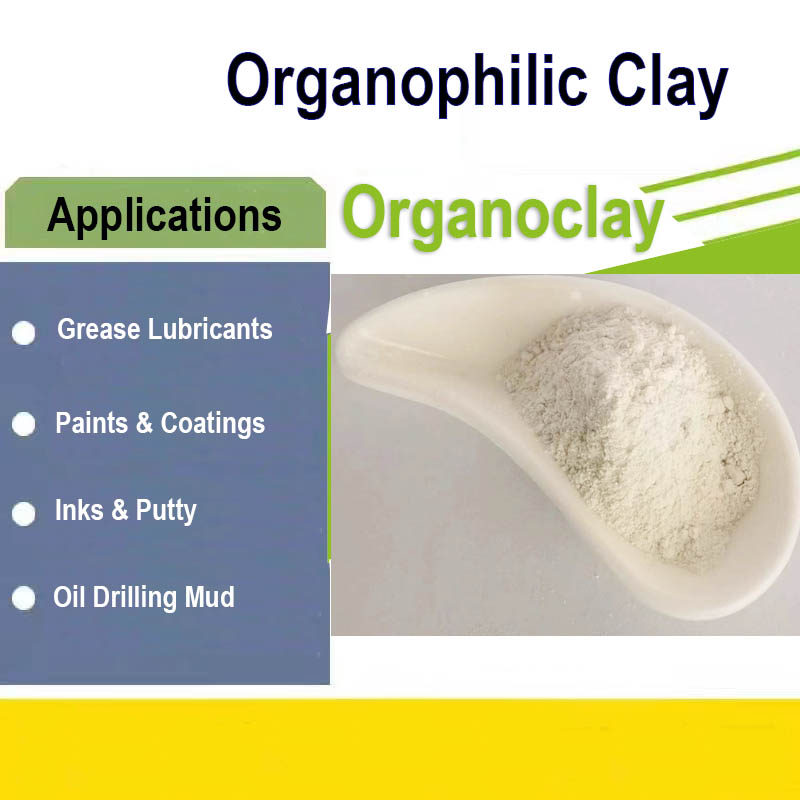Organophilic clay chemicals used in fracking
What is Fracking?
The energy sector has been revolutionized by fracking, which has made vast quantities of previously unattainable resources accessible. However, concerns over its impact on the planet have made it a contentious issue in recent years.
Depending on the well and area, the exact mix of chemicals used in fracking fluid can be different. Fracking fluid chemicals could cause groundwater poisoning, air pollution, and the release of dangerous substances into the surrounding environment. Some environmental problems have been caused by mistakes or the wrong way to handle chemicals during the digging process.
What Chemicals are Used in Fracking?
Hydraulic fracturing uses fracking fluid. Water, proppants, and chemicals are usually in this fluid. The drilling company, geological formation, and municipal legislation determine fracking fluid composition. Hydraulic fracturing relies on organophilic clay to suspend weighing components and other solid minerals in rock, soil, and sand. Organophilic clay, a crucial fracking ingredient, suspends well.
Organophilic Clay’s fracture properties are many. It may swiftly interact with the fluid system since it disperses and self-activates. Diesel, low aromatic mineral oil, modified vegetable oil, and synthetic base fluid compositions benefit from this. Organophilic clay’s ability to suspend solid particles in hydraulic fracturing fluid makes it efficient. Clay keeps proppants, sand, and other solids from settling or agglomerating.
How Many Chemicals are in Fracking Fluid?
Hydraulic fracturing uses fracking chemicals. Most of the time, this fluid is made up of water, sand or other fillers, and different chemicals. The exact ingredients of chemicals used in fracking can change based on things like the rock formation being drilled into, the tastes of the drilling business, and local laws.
Organophilic Clay is a useful chemical that is added to the hydraulic fracturing process to improve the way that weighing materials and other solid minerals in rock, dirt, and sand stay in suspension. Organophilic clay is a key part of fracking, and it works well as a stabilizing agent.
It is easy to spread out and self-activates, which means it can interact with the fluid system quickly and effectively. This trait is especially helpful in formulas that use gasoline, low odor mineral oil, modified veggie oil, or synthetic base fluids.
Organophilic clay works well in hydraulic fracturing because it keeps solid objects suspended in the fracture fluid. Clay keeps these pieces from setting or sticking together, so proppants, sand, and other solid materials are spread out evenly throughout the fluid.
Why are Chemicals Used in Fracking?
Chemicals are added to the fracking solution to make it work better and make the process of breaking more effective. These chemicals help make and keep cracks in the rock layers, which lets hydrocarbons be taken out.
Gelling agents, like Organoclay or organophilic clays, are another type of chemical used in fracking to help move proppants into cracks. These substances are made to make the thickness of the fracking fluid thicker, making it more gel-like and better able to hold and move the proppants.
When gelling agents are added to the fracking fluid, they improve its ability to move and spread proppants, such as sand or clay beads, into the cracks made in the rock forms. The higher viscosity of the fluid keeps the proppants from settling too quickly.
Hydraulic Fracturing for Oil and Gas: Impacts from the Hydraulic Fracturing Water Cycle on Drinking Water Resources
Fracking has enhanced energy output, but it may harm drinking water. Due to hazardous compounds, the hydraulic fracturing water cycle may influence drinking water quality and availability.
Hydraulic fracturing requires plenty of water. It comes from adjacent freshwater reservoirs, rivers, lakes, or aquifers. Such massive water extraction may deplete local water supplies, affecting adjacent residents and ecosystems’ drinking water.
Water, proppants, and chemicals make up fracking chemicals. The fluid is mostly water and sand, but the chemical additions are concerning. These additives may provide environmental and health hazards. Some chemicals used in fracking fluid may contaminate local water sources, especially drinking water wells, if spilled or handled improperly.
Flowback and produced water are created after fracking. Salts, heavy metals, naturally occurring radioactive elements, and other pollutants are common in this effluent. This wastewater contains fracking chemicals and may pollute drinking water if not adequately processed.
How to Remove Contaminants in Water with Organoclays
After mechanically emulsifying the oil, economically coalescing the oil droplets reduces oil and grease concentration to non-detectable levels, making wastewater recycling possible. This needs knowledge of post-polishing processes, especially organoclays. Organoclays remove oil and grease from water sevenfold better than activated carbon.
These organic-modified clays attract and trap oil and grease molecules. Organoclays expedite elimination and purify water. This improves wastewater treatment systems. They improve water quality by separating oil and grease. Their excellent adsorption capacity and efficiency save money by decreasing activated carbon or other treatment chemicals. Organoclays in wastewater treatment need careful consideration of dose, contact duration, and flow rates. Optimization and monitoring assure optimal performance and cost-effectiveness.
Organoclay Chemicals used in Fracking
Organophilic clay helps fracking fluids suspend and disperse weighing components and other solid minerals in rock, soil, and sand. Organophilic clay maintains suspension qualities in hydraulic fracturing as a chemical addition..
Properties
Organoclay chemicals are made up of and have unique qualities. Most of the time, these chemicals are made from biologically modified bentonite clay. This makes them a very useful and flexible part of hydraulic fracturing activities.
Composition
Organoclay chemicals are mostly organic-modified bentonite clay. Fracking applications benefit from this clay alteration process. Organic modification improves clay adsorption and dispersion.
Appearance
Typically found in the form of finely divided powder. They range in color from off white to tan, which is a result of the composition and modification process.
Moisture Content
Most of the time, organoclay materials used as fracking fluid chemicals have a wetness level of 3.5% or less. The amount of wetness in organoclay chemicals is an important factor that affects how well they work.
Specific Gravity
About 1.7 is the specific gravity of the chemicals that make up organoclay. Specific gravity is a way to compare how dense something is to how dense water is. The specific gravity of organoclay materials shows how much they weigh and how dense they are. This can help you figure out how much to use and how they behave in the fracking fluid.
Bulk Density
Have a bulk density between 0.40 and 0.60 g/cm3. The bulk density of organoclay materials tells us how well they can be packed and how they should be handled.
Advantages
Organoclay chemicals used in fracking have a lot of benefits that make them very popular in the business world. One big benefit is that they can keep weighing materials and other objects in suspension in the fracking stream. This makes sure that these materials are spread out in the best way possible during the fracturing process. This leads to better crack formation and better oil extraction.
Organoclay chemicals also keep their ability to stay in solution over a wide range of temperatures, which makes them useful in many different situations. Another benefit is that they don’t need any extra chemical activators. This makes the fracking process easier and makes the fluid mixture less complicated.
Organoclay poisons are also easy to spread out, so they have their impacts quickly. Organoclay chemicals are a good choice for fracking because they have all of these benefits. This makes sure that solids stay in suspension throughout the process.
Application
Zhejiang Camp-Shinning organophilic clay CP-160, find crucial applications as frac fluid additives in the fracking industry. CP-160 is a self-activating agent that exhibits rapid yield development, high gel strengths, and increased efficiency.
- Viscosifying drilling fluids
- All oil-based drilling fluids
- Invert emulsion fluids
- Workover fluids
- Fracture fluids
- Diesel Oils
- Mineral Oils
- Synthetic Oil
- Linear and isomerized Alpha Olefins
Safety
Material Safety Data Sheets (MSDS) contain all of the safety information that Zhejiang Camp-Shinning needs to make sure that its goods are safe. These sheets have specific information about the possible dangers of their materials and instructions for how to handle, store, and get rid of them safely.
Package
Organoclay from Zhejiang Camp-Shinning can be packed in a Kraft paper bag with a PE layer, in a multi-wall paper sack, or in a way that is designed just for it. The normal weight limit for the bags is 25 kg, or 22.68 lb., but they can be changed to fit your needs. The Kraft paper bags with PE liners add an extra layer of protection against wetness, which keeps the goods from getting damaged. Multi-wall paper sacks are strong and durable so that they can be moved and stored safely.
Storage
Zhejiang Camp-Shinning CP-160 should be kept in a dry, well-ventilated room. Keep it in an area with a temperature between 0°C and 30°C. This makes sure that orgaoclay stays stable and intact. The quality guarantee term for organophilic clay CP-160 from Zhejiang Camp-Shinning is 24 months, which shows that it will last a long time if it is kept in the right way.


